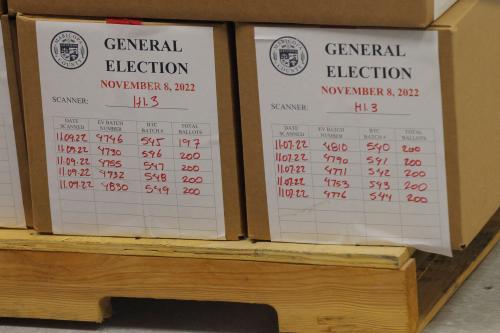Editor’s Note: Experts from the Middle East Youth Initiative continue to monitor the effects of the global economic crisis on the region’s markets. This comes as a continuation of our earlier series: “Food, Fuel, and Finance: How Will the Middle East Weather the Global Economic Crisis?
Navtej Dhillon: Lebanon’s GDP growth is projected to slow in 2009 due to the effects of the global recession. Which sectors have been driving growth until now in Lebanon?
Jad Chaaban: Lebanon is well-integrated into the global economy, therefore, according to IMF projections, there will be a slowdown in the economy for 2009. The drivers of Lebanon’s growth have been mainly services and the construction sector. Between 2001 and 2007, real GDP growth in Lebanon grew by an average of 4 percent a year. We had a drop of minus 5 percent because of the [July 2006] war, and then after the war there was the boom because of reconstruction. But even before the July war, we had modest performance in the country.
The drivers were mainly the telecommunications sector and construction. In terms of numbers, we had 8 percent growth in transport and telecom – so mainly telecommunications – between 2001 and 2005, followed by construction, which grew by 6 percent. Other sectors like trade services and industry grew by an average of 4 percent over 2001 to 2007, the years for which we have data. However, what is interesting is that agriculture didn’t grow – toward zero percent or 0.1 percent – which is something quite interesting for the Lebanese economy.
In terms of contributions to GDP growth, and this is the striking number: services contributed to 93 percent of growth, while construction followed with 19 percent. This is in terms of overall contributions to growth. Why is it 19 percent? Because agriculture and industry actually declined over this period, by minus 1 and minus 7 percent, respectively, and trade declined also by 18 percent, as a share of growth.
What this is telling us is that Lebanon is experiencing something which we call “Dutch disease:” when one sector is booming – in the case of Lebanon, construction and services – this sector, or these sectors, absorb most of the resources. Therefore, you have wages in other sectors affected, and you have resources drawn away from agriculture and industry toward construction and services. Land prices increase – this is what we witnessed over the last period – causing agriculture, trade and other sectors to decline. Basically, these are tradeable sectors which can drive lots of employment, and these have declined at the expense of big real estate projects that were the drivers of growth.
This situation is typically dependent on remittances. As you know, Lebanon has almost 22 percent of GDP in remittances and is among the top six countries in the world in terms of remittance inflow…So, what is happening to Lebanon’s growth? It is typically driven by remittance inflow that finances major real estate projects at the expense of investments that are, if you will, more productive or don’t drive real estate prices up.
Dhillon: Which sectors do you think will be the most affected by the global recession in the short run? In the longer term, will the Lebanese economy emerge stronger or weaker after the current crisis subsides?
Chaaban: Typically, in the context of a global recession, two things might affect the Lebanese economy. The first is a decline in remittances because new numbers from the World Bank show that remittances might decline globally by about 10 percent over the next year. Therefore, if you expect Lebanese remittances to drop, this will immediately affect the real estate sector, which has been one of the main drivers of Lebanon’s growth.
The second is trade, with the decline in demand in Europe, the U.S., and the Gulf… [Lebanon] mainly exports to the Gulf markets, followed by the EU and the U.S. We don’t know yet what the outcome will be for the Gulf because it really depends on the forecast for oil prices, but you can expect that Lebanese exports will drop.
This is typical for an economy which, in development, we call “dependent.” We depend on remittances as a country; we depend on foreign aid – especially after the recent war, Lebanon has counted on almost $7 billion in foreign aid, which is about 20 percent or 25 percent of GDP. Then, there is 22 percent [of GDP] from remittances, and then relying a bit on foreign trade, the economy is basically producing very little, and all the money that has flowed in is invested in real estate and construction projects.
Thus we have a cycle that is vulnerable to global economic recessions, in the medium term. In the short term, we are not affected – maybe mildly – but if this worsens we might see some effects over time.
Dhillon: You mentioned that 93 percent of growth comes from the services sector. Do you see any impact on that sector from potential return migration back to Lebanon? Since you mentioned that remittances might decline, will there be opportunities for people coming back in search of jobs, for example?
Chaaban: The thing about Lebanese migration, unlike other types of migration, is that some statistics show that around 75 percent of migrants have more than a graduate diploma (a university and a graduate diploma). So, it is typically high-skilled migration. This is why the Lebanese will not immediately return to Lebanon. What we read in the media, especially in the local media, was a bit inflated regarding this issue. What we are witnessing is that when there are jobs that are being lost for some project in the Gulf, the Lebanese are going somewhere else and not returning immediately to Lebanon. This is due to their high skill level and their experience, so they can recycle very quickly in the labor market. Some have been going to other emerging markets like Northern Iraq, some countries in Africa – like Nigeria, Algeria, or other countries – and some have been migrating to Europe or the U.S. We are seeing a phenomenon called “circular migration,” where the Lebanese that went to the Gulf now are migrating to the EU, North America or even Australia. The number of Lebanese going back is, in my opinion, very little, because those who migrated are highly skilled and are searching for very high wages that are not available in Lebanon. Even if there are opportunities created in the market, the local market, these migrants probably would not accept the wages due to their high expectations.
The services sector will be affected, of course, by the decline in remittances and by any transfer of money to the local economy. The services sector relies on real estate investments, construction and telecommunications. Resilient sectors are education, regional media and intermediation services, international organizations and health services.
Dhillon: In the context of the downturn in global financial markets, can you give us an overview of Lebanon’s financial sector and some of its relative strengths and weaknesses in approaching the downturn? The country’s banking system seems to have avoided many of the negative consequences of the global economic crisis. Is this the case and, if so, to what do you attribute it?
Chaaban: Yes, Lebanon avoided the financial crisis. We haven’t had any bank collapsing or any bank losing major assets, especially on the global financial markets. This is due to many factors. First, in Lebanon we have very powerful commercial banks. There are fifty-five commercial banks: of course, there are around 10 very big banks that control most of the assets and deposits, but the remainder of the banks, all of them, have a presence in the country and also have a big presence in the region and abroad.
Just to give you a number: bank deposits are above 300 percent of GDP, which is an exceptional number. The banks in Lebanon are managing a huge amount of money that is deposited, and they are contributing to basically managing inflows and outflows of capital, especially remittances. In a country that relies so much on migration and on foreign transfers, you must have a good banking sector. This is why it is a strong sector.
Also, a major aspect is that it is very strongly regulated. Now, this is kind of cynical, but in Lebanon we have had so many crises and so much instability that the regulators became used to this environment. This is why, when we had this economic crisis now, the banks in Lebanon emerged very stable because, you can say, they are used to it.
There is also legislation in place that has helped the banks to emerge from the crisis untouched. First, almost five years ago, the Central Bank imposed a ban of any direct investment by commercial banks in the real estate sector, which protected banks from the collapse of the real estate market and subsequent crisis in the U.S. Second, the minimum capital requirement set by the Central Bank was set at 12 percent a long time ago, compared to international requirements around 8 percent in 2002. They were conservative in terms of capital requirements.
Finally, all credit claims that are made by the commercial banks are submitted to a risk assessment center [The “Centrale des Risques” and the Banking Control Commission (BCC)], which basically clears that names or credit issues are not risky. Banks are not allowed to give credit beyond 20 percent for local claims and 5 percent for foreign claims. So this is a ceiling on the share of claims in total assets.
These are, if you will, on the bright side of the story. There is a certain risk that the banks face, which is their exposure to sovereign risk, or basically government debt. Twenty-seven percent of the Lebanese banks’ assets are in treasury bonds, or public debt. Public debt is around 60 percent of total credit owned by the banks which is, by international standards, very high. For Lebanon, almost 200 percent of GDP is in public debt. That is almost $44 billion.
While the level of debt might be very high, this is not quite as bad as one may think because most of the debt is owned by the Lebanese banks and by the Central Bank. So, we are lending to ourselves, and only recently did we get some foreign lending. More than 60 percent of the debt is locally owned, which means we are self-managing, or self-creating, a debt that is within the borders, and this is why there is low global risk. The problem of course for the banks is that if the government decides to default or, for any reason, decides to drop the exchange rate peg or something, then there will be a problem in the banks’ assets because such a large portion of their assets are denominated in Lebanese treasury bonds.
Dhillon: Recently, a constitutional amendment was passed and the voting age in Lebanon was lowered to 18. What do you think will be the primary issues motivating youth to go to the polls for the country’s parliamentary elections in June?
Chaaban: This legislation represented a huge change, and the numbers show that there will be about a 9 percent increase in the electorate due to the lowering of the voting age, which is significant.
Now, what will the youth be voting on? Lebanese politics has become very polarized, especially around two political currents which we call the “March 14” and the “March 8” coalitions. You can see this in the electoral polls and in a recent UN study about the specific attitudes of young people in school [See: UNDP, “Education and Citizenship: Concepts, Attitudes, Skills and Actions,” 2008]. The primary thing they mentioned [as a factor in] their political ideology was the personality of the leader. This report also revealed some worrying aspects of sectarian or confessional trends. Thus, young people will probably be voting along the lines of their families and their political allegiances to local leaders, rather than for programs or agendas, and this is quite worrying.
Dhillon: In research that you have done for the Middle East Youth Initiative’s Costs of Youth Exclusion paper, you have shown that youth joblessness alone is costing the region nearly 7 percent of its GDP annually. What are the challenges – and perhaps some of the opportunities – for regional policymakers focusing on youth employment during this global downturn? Is it going to be possible for these policymakers to enact labor policies, for example, that support long-term growth but that are not perceived as unpopular policies during this time when people are more averse to risk and uncertainty?
Chaaban: As you mentioned, the region is facing an unprecedented number of jobless young people. This is a major challenge. Even in times of growth, economic growth was not leading to jobs being created for the big number of entrants into the labor market. Typically, governments in the region were resorting to government employment as a means of absorbing the growing number of entrants into the labor market, and also encouraging – not directly, but kind of as a passive policy – migration. You can see this in Egypt, Syria, Jordan, Lebanon and Morocco: all of whom either rely on government employment and, when the government budget is not enough, will implement a passive migration policy.
Because of the global recession and the drop in demand in Europe, there will be pressure on migrants from North Africa. There will be less jobs – even in the informal sector and unskilled labor – for young migrants. At the same time, with the potential decline in the Gulf markets, there will also be less work opportunities for skilled and unskilled young migrants.
Domestically, governments are facing a rough time in terms of budgets, because the recession means less income from taxes and therefore less money to spend on programs. This is why they are relying more on private sector initiatives that might create jobs and less on major public projects: they are strained on money, and employment in the public sector already is creating a big liability in terms of salaries and employment benefits and, most importantly, retirement. There will be a very big pension pressure on some governments because they have employed so many people in the past. We are seeing this in Egypt, Lebanon and Syria: all of these countries are facing severe pressures on social security.
Thus, the government cannot really continue doing the same “business as usual,” and they are trying to rely on the private sector for ideas and initiatives. This is working in some countries, like Jordan, where there are some initiatives that are bringing jobs to young graduates, but the problem we are seeing is that there is too much imitation and very little coordination among countries. So each country wants to create, or wants to attract, investors in information technology (IT), in tourism, even in health care and we are seeing that there is too much competition and imitation between countries and very little coordination.
I think there are tremendous opportunities for increasing coordination and stimulating intra-regional trade, services and expertise. In the Middle East region, trade is very low between countries and yet there is a lot of complementary potential between countries. This is something that can be explored in terms of the potential to create jobs around export sectors.
At the same time, there are sectors that can create jobs that have not really been put on top of the agenda. Especially in areas like sustainable development, alternative energy, and also areas that are pertaining to agro-food production, and especially the water sector. The region is facing tremendous challenges in terms of its food security, and there are many resources that are untapped, especially using water projects or massive public works projects to create some kind of infrastructure for better agro-food industries. There are many successful cases that can be looked at.
With a huge population that shares the same culture or the same language, there is great room for cooperation and there is a need not to create projects that can be competing but rather can complement each other. So, let us say a country uses some equipment that is shipped to another country where it is assembled, you would have multi-stage industries that could be created, like the example of India or other countries who have followed this kind of model.
In terms of policies that the government can implement: I don’t think it is enough to create an investor-friendly environment. I think the government needs to put intensive effort toward jobs for young people, especially in sectors that have not been at the top of the list before like agriculture, agro-business, alternative energy and sustainable development. Some examples of policies include: giving tax breaks for investments in these sectors, putting some money toward research and development to create more production ideas for these industries, and reducing trade barriers and movement barriers for entrepreneurs, and especially young people, in the region. Many young people still face very strong visa requirements because of strong business legislation in countries like Egypt and Morocco. So, in these areas, there is room for cooperation and less competition.



Commentary
Global Economic Crisis: Prosperity and Politics in Lebanon
May 4, 2009